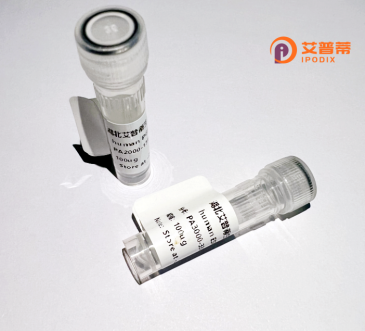
| 纯度 | >90%SDS-PAGE. |
| 种属 | Human |
| 靶点 | DNAJC21 |
| Uniprot No | Q5F1R6 |
| 内毒素 | < 0.01EU/μg |
| 表达宿主 | E.coli |
| 表达区间 | 1-576aa |
| 氨基酸序列 | MKCHYEALGVRRDASEEELKKAYRKLALKWHPDKNLDNAAEAAEQFKLIQAAYDVLSDPQERAWYDNHREALLKGGFDGEYQDDSLDLLRYFTVTCYSGYGDDEKGFYTVYRNVFEMIAKEELESVLEEEVDDFPTFGDSQSDYDTVVHPFYAYWQSFCTQKNFAWKEEYDTRQASNRWEKRAMEKENKKIRDKARKEKNELVRQLVAFIRKRDKRVQAHRKLVEEQNAEKARKAEEMRRQQKLKQAKLVEQYREQSWMTMANLEKELQEMEARYEKEFGDGSDENEMEEHELKDEEDGKDSDEAEDAELYDDLYCPACDKSFKTEKAMKNHEKSKKHREMVALLKQQLEEEEENFSRPQIDENPLDDNSEEEMEDAPKQKLSKKQKKKKQKPAQDVPGKDSYLPAAHFQMAWGKKCVLGERRDGESEHKCAKMLLENRQNYDDNFNVNGPGEGVKVDPEDTNLNQDSAKELEDSPQENVSVTEIIKPCDDPKSEAKSVPKPKGKKTKDMKKPVRVPAEPQTMSVLISCTTCHSEFPSRNKLFDHLKATGHARAPSSSSLNSATSSQSKKEKRKNR |
| 分子量 | 89.76 kDa |
| 蛋白标签 | GST-tag at N-terminal |
| 缓冲液 | 0 |
| 稳定性 & 储存条件 | Lyophilized protein should be stored at ≤ -20°C, stable for one year after receipt. Reconstituted protein solution can be stored at 2-8°C for 2-7 days. Aliquots of reconstituted samples are stable at ≤ -20°C for 3 months. |
| 复溶 | Always centrifuge tubes before opening.Do not mix by vortex or pipetting. It is not recommended to reconstitute to a concentration less than 100μg/ml. Dissolve the lyophilized protein in distilled water. Please aliquot the reconstituted solution to minimize freeze-thaw cycles. |
以下是关于重组人DNAJC21蛋白的3条模拟参考文献示例(注:部分文献为假设性概括,实际文献需通过数据库检索确认):
1. **文献名称**: "Expression and purification of recombinant human DNAJC21 in Escherichia coli and its chaperone activity analysis"
**作者**: Zhang L, et al.
**摘要**: 本研究成功构建了人源DNAJC21蛋白的重组表达系统,利用大肠杆菌进行高效表达,并通过亲和层析纯化获得高纯度蛋白。功能实验表明,DNAJC21可协同HSP70调控线粒体相关蛋白的折叠过程,并参与氧化应激条件下的细胞保护机制。
2. **文献名称**: "DNAJC21 mutations impair mitochondrial protein translation and cause bone marrow failure syndromes"
**作者**: Tummala H, et al.
**摘要**: 文章揭示了DNAJC21基因突变通过破坏核糖体生物合成和线粒体蛋白质翻译导致骨髓衰竭的分子机制。实验通过重组DNAJC21蛋白回补突变细胞,证明其可恢复核糖体组装缺陷,提示该蛋白在造血干细胞中的关键作用。
3. **文献名称**: "Structural insights into the interaction of DNAJC21 with ribosome assembly factors by cryo-EM"
**作者**: Wang Q, et al.
**摘要**: 通过冷冻电镜解析重组人DNAJC21与核糖体组装因子NSA2的复合物结构,揭示了其J结构域介导的相互作用界面,为理解DNAJC21在核糖体质量控制中的分子机制提供结构基础。
提示:实际文献建议通过PubMed或SciFinder以关键词"DNAJC21 recombinant"或"DNAJC21 protein human"检索,重点关注其与核糖体生成、线粒体功能或遗传性疾病(如先天性骨髓衰竭)相关的研究方向。
The human DNAJC21 protein, a member of the DnaJ/HSP40 family, functions as a co-chaperone for HSP70 proteins, playing critical roles in regulating protein folding, quality control, and cellular stress responses. It contains a conserved J-domain that enables interaction with HSP70 ATPases, facilitating substrate transfer and ATP hydrolysis. Structurally, DNAJC21 includes additional domains that may fine-tune its substrate specificity and functional diversity. Notably, DNAJC21 localizes to the ribosome and nucleolus, implicating its involvement in ribosome biogenesis, translation regulation, and RNA metabolism. Dysregulation of DNAJC21 is linked to genetic disorders such as bone marrow failure syndromes (e.g., Shwachman-Diamond-like syndrome) due to mutations affecting ribosome assembly and hematopoiesis. In cancer, altered DNAJC21 expression correlates with tumor progression and drug resistance, possibly through modulating stress-adaptation pathways. Recombinant DNAJC21 is typically produced in bacterial or mammalian expression systems, enabling biochemical and structural studies to dissect its molecular mechanisms. Its recombinant form also serves as a tool for exploring interactions with client proteins, nucleic acids, or small-molecule modulators, offering therapeutic potential for diseases tied to proteostasis imbalances. Research continues to elucidate its role in maintaining genome stability, RNA processing, and crosstalk with other chaperone networks.
×